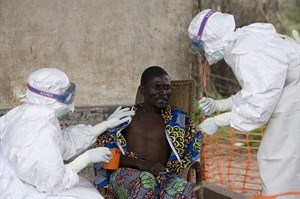
A 43 year old Congolese patient, center, who has been confirmed to have Ebola hemorrhagic fever, is comforted by Medecins Sans Frontieres (Doctors without Borders) nurse Isabel Grovas, left, and Doctor Hilde Declerck, right, in Kampungu, Kasai Occidental province, Congo, on Sept. 29, 2007. Canadian researchers are reporting on a therapy that could stop people exposed to deadly Ebola viruses from developing the disease. THE CANADIAN PRESS/AP - HO, Christopher Black
June 13, 2012 - 1:59 PM
TORONTO - Canadian researchers are reporting a potential advance in the treatment of Ebola virus infection, one of the most deadly pathogens known to humankind.
The team is reporting that monkeys infected with Ebola were successfully saved with a treatment made of a cocktail of antibodies.
Four of four monkeys given the treatment 24 hours after infection survived. And two of four monkeys treated 48 hours after infection also survived.
Senior author Gary Kobinger says the goal is to get a treatment that works 72 hours after exposure, because in an outbreak situation one generally can't be sure someone is infected until about three days after exposure.
Kobinger is the head of the special pathogens program at the National Microbiology Laboratory in Winnipeg, which is part of the Public Health Agency of Canada.
The work, published in the journal Science Translational Medicine, is being hailed as a promising step forward in a field that has long defied the efforts of top scientists.
"Our researchers have seen first hand the terrible effects of the Ebola virus on populations in Africa," says Dr. Frank Plummer, scientific director of the Winnipeg lab and chief science officer at the Public Health Agency of Canada.
"This discovery should pave the way for the development of a new drug that has the potential to save many lives."
Plummer's enthusiasm was echoed by Dr. Pierre Formenty, team leader for epidemic and emerging diseases at the World Health Organization.
"It's excellent science," Formenty says. "And it's very hopeful for us."
In an interview from Geneva, Formenty says this work makes him more optimistic than he's been in years that a usable tool against Ebola may be in sight.
The work involved infecting macaque monkeys with Ebola Zaire, the deadliest species of Ebola viruses. In outbreaks triggered by the Zaire strain of Ebola, as many as 90 per cent of people infected may die.
The monkeys were treated with a combination of three monoclonal antibodies, specific antibodies against the protein on the outside of the Ebola virus that are isolated and cloned.
Previous efforts to treat Ebola with monoclonal antibodies — a single antibody or a pair of antibodies — had limited success.
Kobinger's team identified eight monoclonal antibodies that might work, but homed in on three to try to reduce the cost of producing the treatment. Monoclonal antibodies are typically expensive to generate.
"We thought that the combination of three would be viable and that we would get a lot of efficacy out of three. But it was a little bit of guestimating at that moment," he admits.
This cocktail would only counter Ebola Zaire. If this form of therapy is put into the field, different antibody combinations would be needed to treat people infected with Ebola Sudan, Ebola Bundibugyo and the other species of the virus.
News from © The Canadian Press, 2012